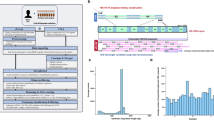Abstract
Recent studies on microbiome highlighted their importance in various environments including human, where they are involved in multiple biological contexts such as immune mechanism, drug response, and metabolism. The rapid increase of new findings in microbiome research is partly due to the technological advances in microbiome identification, including the next-generation sequencing technologies. Several applications of different next-generation sequencing platforms exist for microbiome identification, but the most popular method is using short-read sequencing technology to profile targeted regions of 16S rRNA genes of microbiome because of its low-cost and generally reliable performance of identifying overall microbiome compositions. The analysis of targeted 16S rRNA sequencing data requires multiple steps of data processing and systematic analysis, and many software tools have been proposed for such procedures. However, properly organizing and using such software tools still require certain level of expertise with computational environments. The purpose of this article is introducing the concept of computational analysis of 16S rRNA sequencing data to microbiologists and providing easy-to-follow and step-by-step instructions of using recent software tools of microbiome analysis. This instruction may be used as a quick guideline for general next-generation sequencing-based microbiome studies or a template of constructing own software pipelines for customized analysis.
Similar content being viewed by others
References
Benítez-Páez, A., Portune, K.J., and Sanz, Y. 2016. Species-level resolution of 16S rRNA gene amplicons sequenced through the MinION portable nanopore sequencer. Gigascience5, 4.
Bolyen, E., Rideout, J.R., Dillon, M.R., Bokulich, N.A., Abnet, C.C., Al-Ghalith, G.A., Alexander, H., Alm, E.J., Arumugam, M., Asnicar, F., et al. 2019. Reproducible, interactive, scalable and extensible microbiome data science using QIIME 2. Nat. Biotechnol.37, 852–857.
Bray, J.R. and Curtis, J.T. 1957. An ordination of upland forest communities of southern Wisconsin. Ecol. Monogr.27, 325–349.
Callahan, B.J., McMurdie, P.J., Rosen, M.J., Han, A.W., Johnson, A.J., and Holmes, S.P. 2016. DADA2: High-resolution sample inference from Illumina amplicon data. Nat. Methods13, 581–583.
DeSantis, T.Z., Hugenholtz, P., Larsen, N., Rojas, M., Brodie, E.L., Keller, K., Huber, T., Dalevi, D., Hu, P., and Andersen, G.L. 2006. Greengenes, a chimera-checked 16S rRNA gene database and workbench compatible with ARB. Appl. Environ. Microbiol.72, 5069–5072.
Dethlefsen, L., Huse, S., Sogin, M.L., and Relman, D.A. 2008. The pervasive effects of an antibiotic on the human gut microbiota, as revealed by deep 16S rRNA sequencing. PLoS Biol.6, e280.
Faith, D.P. 1992. Conservation evaluation and phylogenetic diversity. Biol. Conserv.61, 1–10.
Hamady, M. and Knight, R. 2009. Microbial community profiling for human microbiome projects: Tools, techniques, and challenges. Genome Res.19, 1141–1152.
Hayashi, H., Sakamoto, M., and Benno, Y. 2002. Phylogenetic analysis of the human gut microbiota using 16S rDNA clone libraries and strictly anaerobic culture-based methods. Microbiol. Immunol.46, 535–548.
Hills, R.D. Jr., Pontefract, B.A., Mishcon, H.R., Black, C.A., Sutton, S.C., and Theberge, C.R. 2019. Gut microbiome: profound implications for diet and disease. Nutrients11, 1613.
Jaccard, P. 1901. Étude comparative de la distribution florale dans une portion des Alpes et des Jura. Bull. Soc. Vaud. Sci. Nat.37, 547–579.
Janda, J.M. and Abbott, S.L. 2007. 16S rRNA gene sequencing for bacterial identification in the diagnostic laboratory: pluses, perils, and pitfalls. J. Clin. Microbiol.45, 2761–2764.
Katoh, K. and Standley, D.M. 2013. MAFFT multiple sequence alignment software version 7: improvements in performance and usability. Mol. Biol. Evol.30, 772–780.
Kho, Z.Y. and Lal, S.K. 2018. The human gut microbiome — a potential controller of wellness and disease. Front. Microbiol.9, 1835.
Klindworth, A., Pruesse, E., Schweer, T., Peplies, J., Quast, C., Horn, M., and Glöckner, F.O. 2013. Evaluation of general 16S ribosomal RNA gene PCR primers for classical and next-generation sequencing-based diversity studies. Nucleic Acids Res.41, e1.
Langille, M., Zaneveld, J., Caporaso, J., McDonald, D., Knights, D., Reyes, J., Clemente, J., Burkepile, D., Vega Thurber, R.L., Knight, R., et al. 2013. Predictive functional profiling of microbial communities using 16S rRNA marker gene sequences. Nat. Biotechnol.31, 814–821.
Lozupone, C.A., Hamady, M., Kelley, S.T., and Knight, R. 2007. Quantitative and qualitative β diversity measures lead to different insights into factors that structure microbial communities. Appl. Environ. Microbiol.73, 1576–1585.
Mandal, S., Van Treuren, W., White, R.A., Eggesbø, M., Knight, R., and Peddada, S.D. 2015. Analysis of composition of microbiomes: a novel method for studying microbial composition. Microb. Ecol. Health Dis.26, 27663.
Mardis, E.R. 2008. Next-generation DNA sequencing methods. Annu. Rev. Genomics Hum. Genet.9, 387–402.
Mignard, S. and Flandrois, J.P. 2006. 16S rRNA sequencing in routine bacterial identification: a 30-month experiment. J. Microbiol. Methods67, 574–581.
Pehrsson, E.C., Tsukayama, P., Patel, S., Mejía-Bautista, M., Sosa-Soto, G., Navarrete, K.M., Calderon, M., Cabrera, L., Hoyos-Arango, W., Bertoli, M.T., et al. 2016. Interconnected microbiomes and resistomes in low-income human habitats. Nature533, 212–216.
Pielou, E.C. 1966. The measurement of diversity in different types of biological collections. J. Theor. Biol.13, 131–144.
Quast, C., Pruesse, E., Yilmaz, P., Gerken, J., Schweer, T., Yarza, P., Peplies, J., and Glockner, F.O. 2013. The SILVA ribosomal RNA gene database project: improved data processing and web-based tools. Nucleic Acids Res.41, D590–D596.
Schloss, P.D., Westcott, S.L., Ryabin, T., Hall, J.R., Hartmann, M., Hollister, E.B., Lesniewski, R.A., Oakley, B.B., Parks, D.H., Robinson, C.J., et al. 2009. Introducing mothur: open-source, platform-independent, community-supported software for describing and comparing microbial communities. Appl. Environ. Microbiol.75, 7537–7541.
Spellerberg, I.F. and Fedor, P.J. 2003. A tribute to Claude Shannon (1916–2001) and a plea for more rigorous use of species richness, species diversity and the ‘Shannon-Wiener’ index. Glob. Ecol. Biogeogr.12, 177–179.
Woese, C.R. and Fox, G.E. 1977. Phylogenetic structure of the prokaryotic domain: the primary kingdoms. Proc. Natl. Acad. Sci. USA74, 5088–5090.
Acknowledgments
This work was supported by the Gachon University research fund of 2019 (GCU-2019-0319).
Author information
Authors and Affiliations
Corresponding author
Rights and permissions
About this article
Cite this article
Kim, H., Kim, S. & Jung, S. Instruction of microbiome taxonomic profiling based on 16S rRNA sequencing. J Microbiol. 58, 193–205 (2020). https://doi.org/10.1007/s12275-020-9556-y
Received:
Revised:
Accepted:
Published:
Issue Date:
DOI: https://doi.org/10.1007/s12275-020-9556-y




